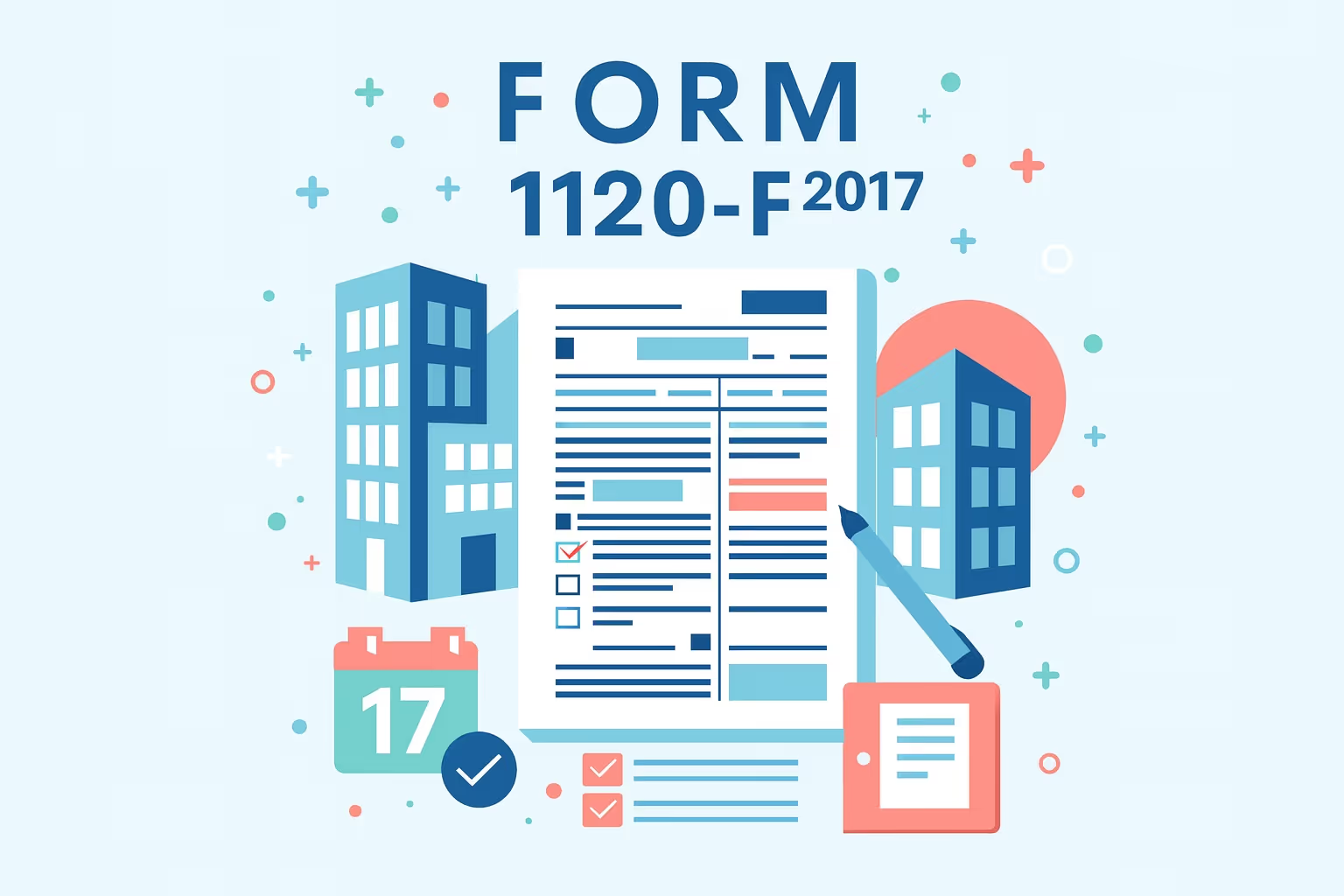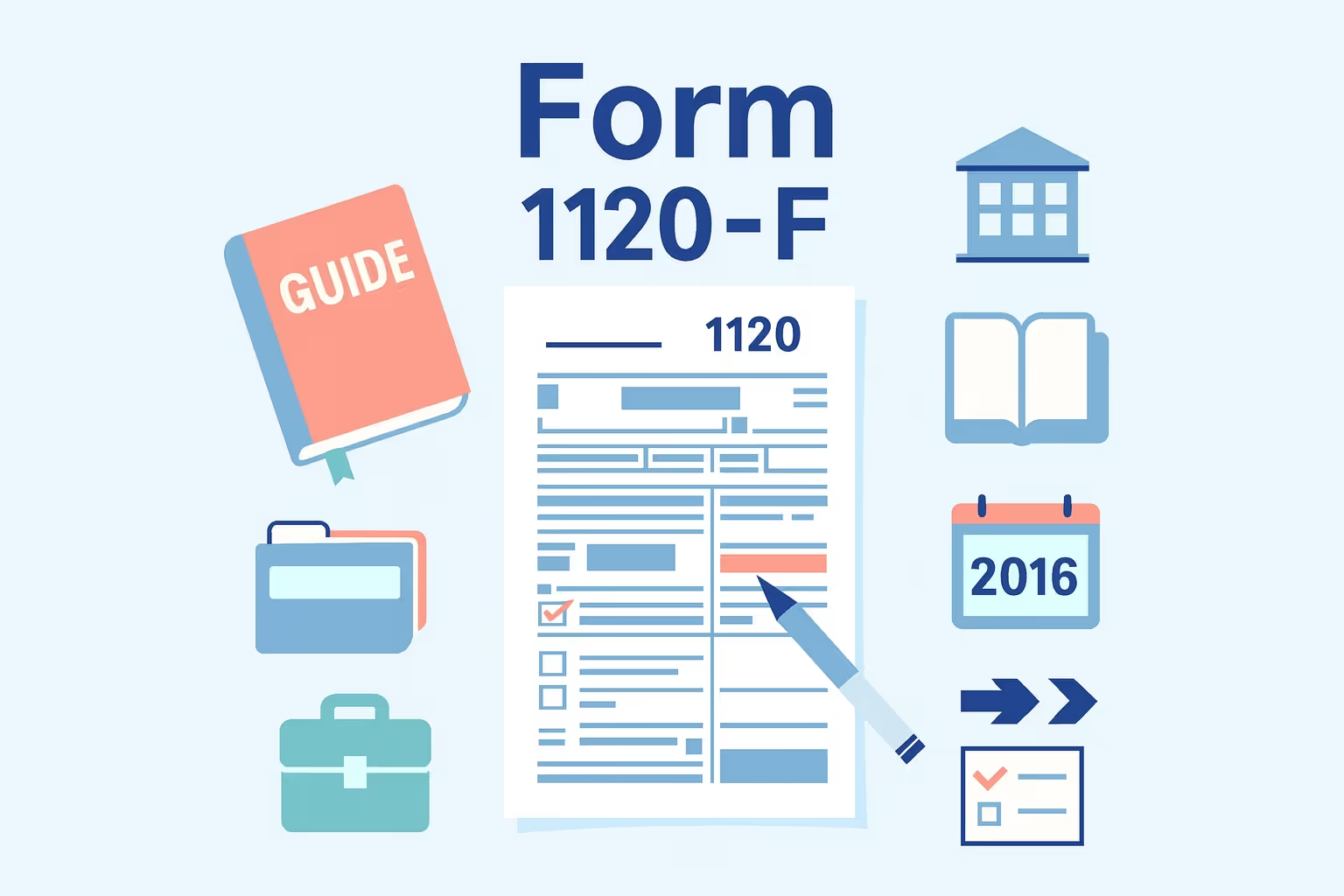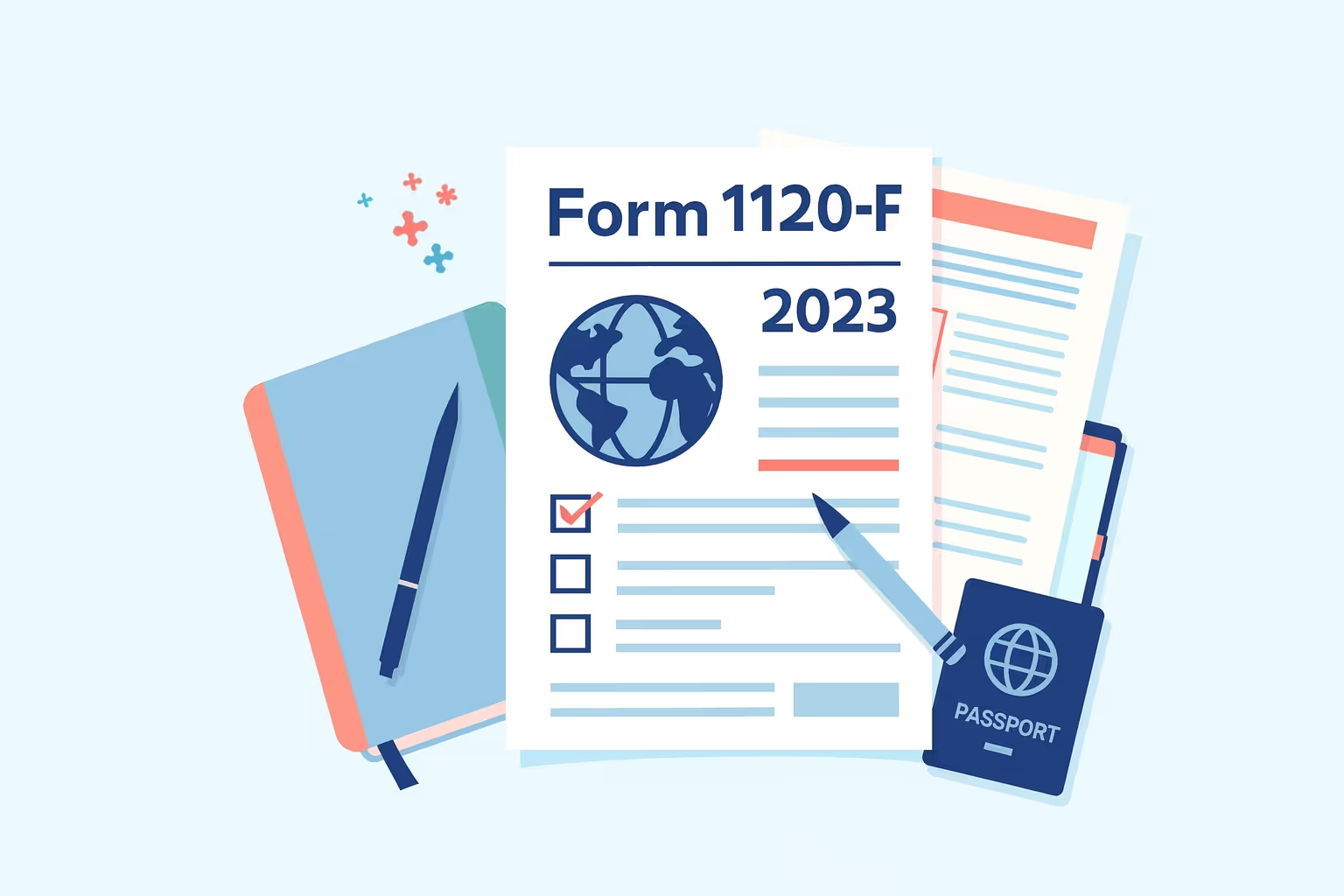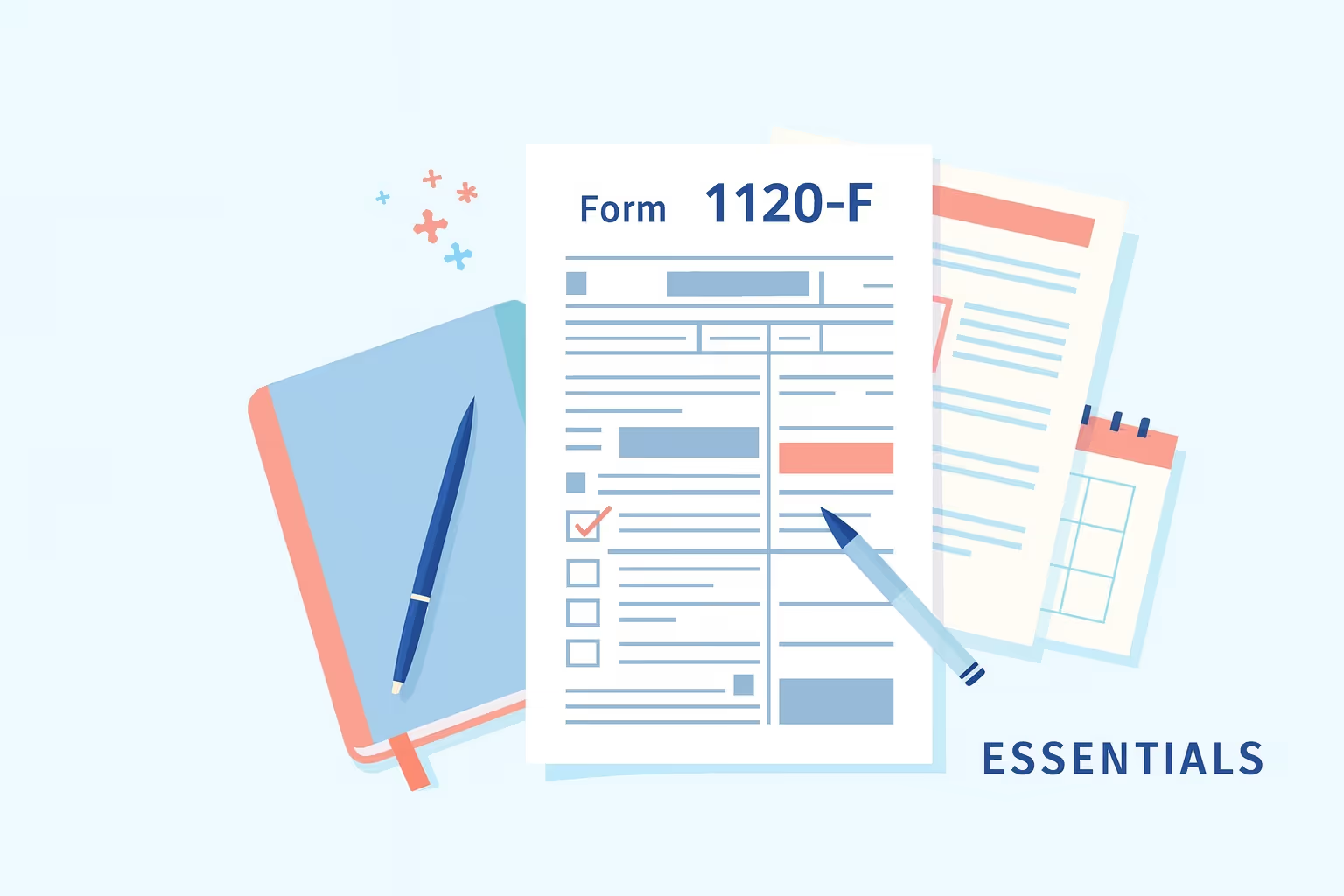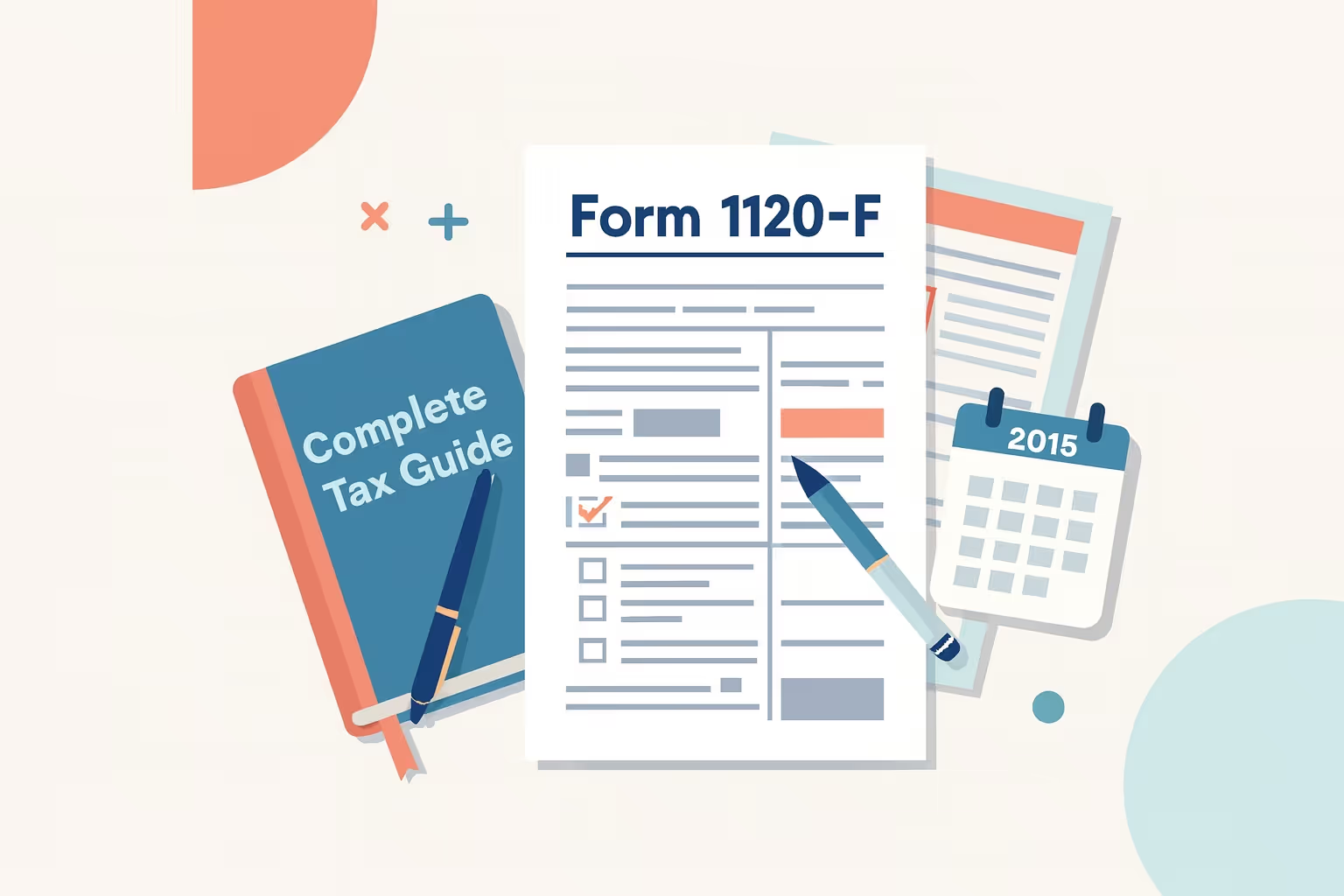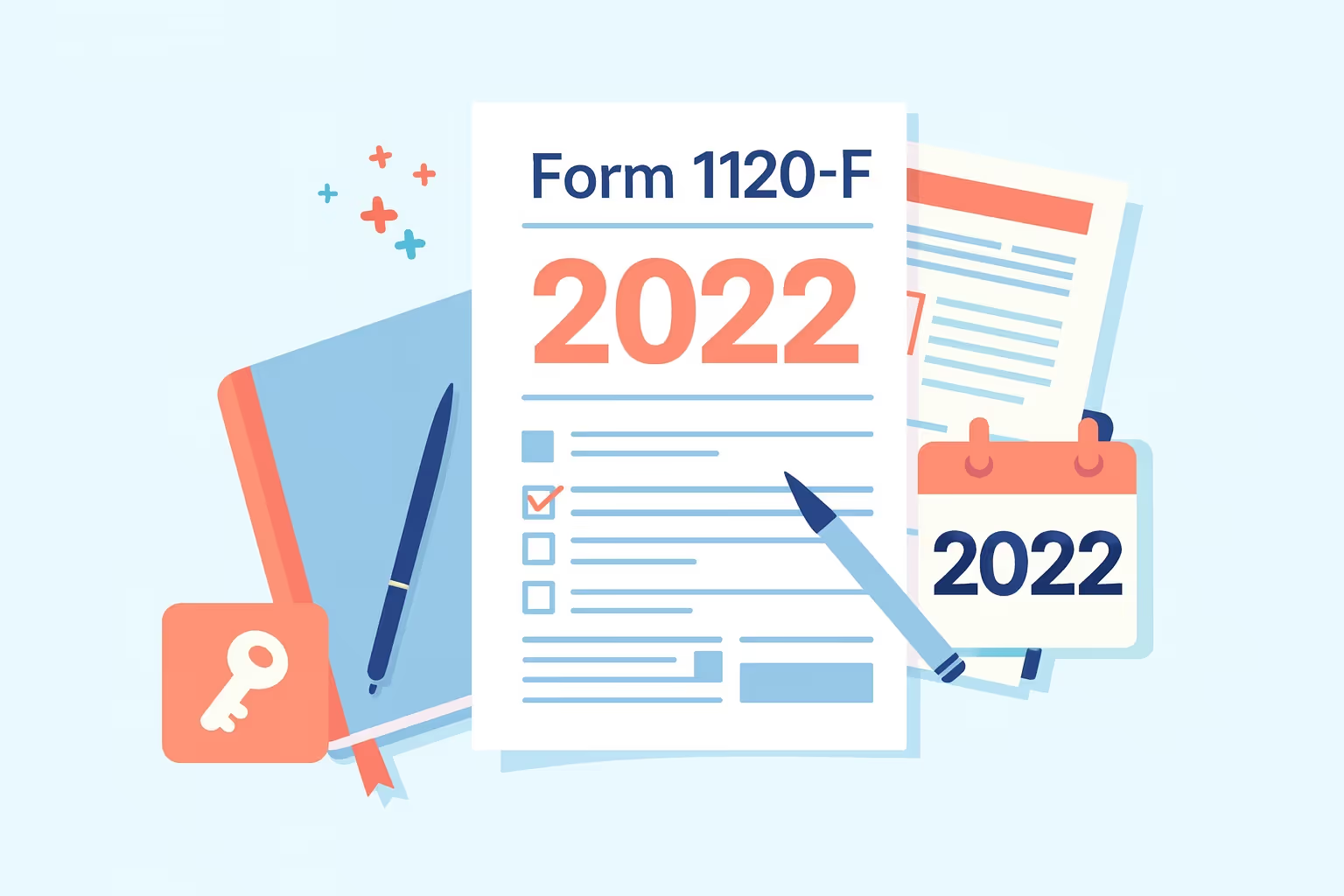Instrucciones del formulario 1120-F 2018: descripción general completa de la presentación
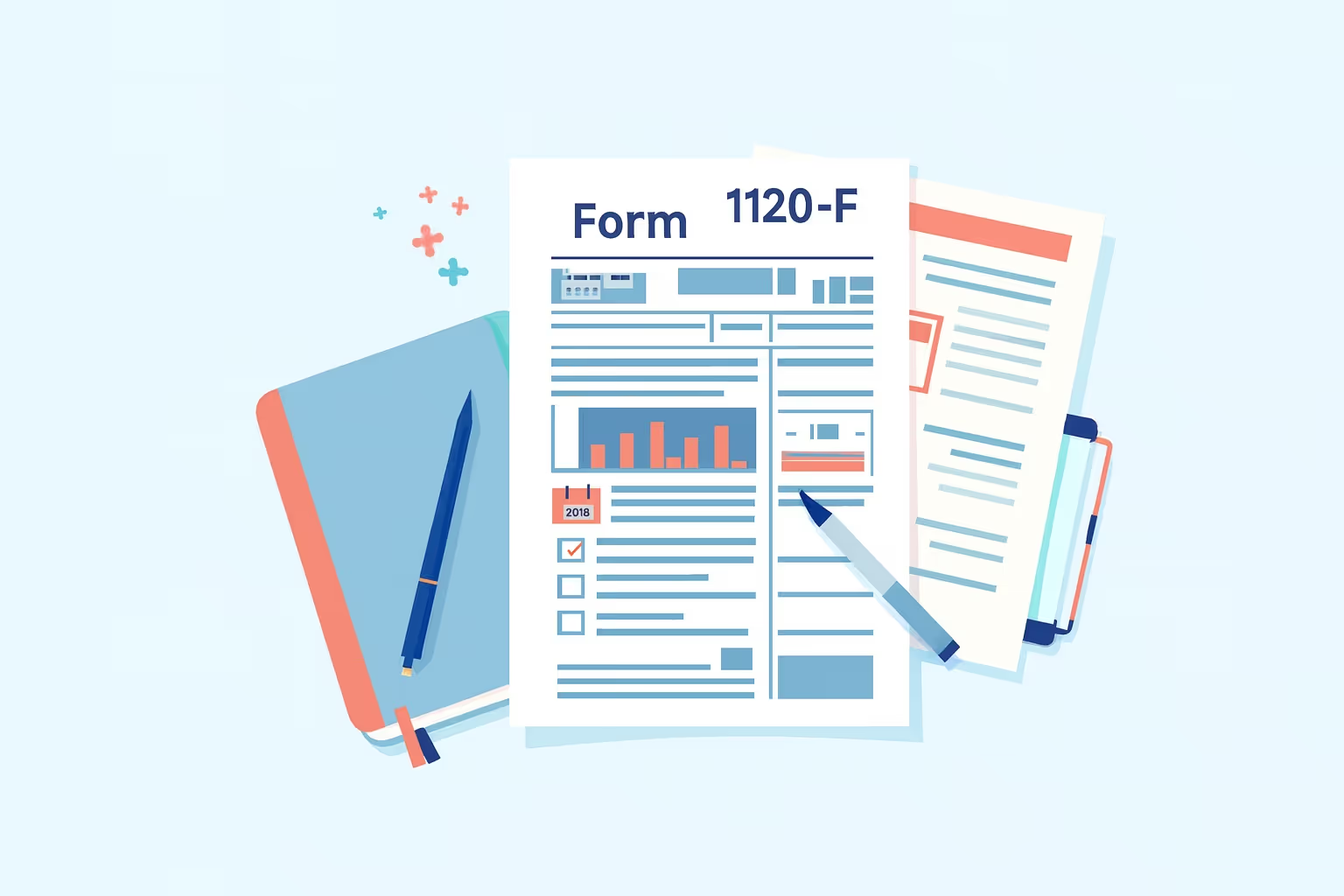
Las empresas extranjeras que operan en los Estados Unidos deben presentar el formulario 1120-F, la declaración federal de impuestos sobre la renta diseñada para entidades extranjeras. Este formulario informa sobre los ingresos, las deducciones y los créditos relacionados de manera efectiva, lo que garantiza que las empresas cumplan con sus obligaciones tributarias corporativas en EE. UU. La presentación correcta evita sanciones, protege los beneficios de los tratados y mantiene el cumplimiento de Servicio de Impuestos Internos requisitos.
El año fiscal 2018 introdujo cambios importantes en virtud de la Ley de Reducción de Impuestos y Empleos, incluida una tasa impositiva fija del 21% sobre la renta corporativa y nuevas normas de presentación de informes. Comprender estas actualizaciones es fundamental para una empresa extranjera que ejerza actividades comerciales o empresariales en EE. UU. Una clasificación adecuada de los ingresos, como los ingresos empresariales frente al FDAP pasivo, tiene un impacto directo en la obligación y el pago tributarios.
Esta guía ofrece instrucciones paso a paso para completar el formulario, explica cómo se aplican los tratados y las exenciones y destaca los errores comunes que se deben evitar. Aclara las empresas con estructuras, asociaciones e intereses inmobiliarios complejos. Con una preparación cuidadosa, una empresa extranjera puede presentar su declaración con precisión y preservar sus valiosos derechos en virtud de la ley tributaria de los EE. UU.
Descripción general del formulario 1120-F y las reglas de presentación
Formulario 1120-F es la declaración de impuestos sobre la renta requerida para las empresas extranjeras que obtienen ingresos de origen estadounidense. Establece los ingresos imponibles y determina la obligación tributaria de la corporación que presenta la declaración.
Quién debe presentar una declaración de impuestos
- Comprometidos en el comercio: Una corporación extranjera con un establecimiento comercial o permanente en EE. UU. debe presentar la declaración, incluso si no se obtienen ingresos imponibles durante el año tributario.
- Ingresos conectados de manera efectiva: Las empresas con ingresos efectivamente relacionados con actividades comerciales, bienes de capital o propiedades de inventario compradas deben declararlos en la declaración de impuestos.
- Reclamaciones de tratados: Si se aplican los beneficios de un tratado, la corporación debe presentar una solicitud para divulgar las exenciones, créditos o solicitudes de tasas convencionales más bajas que reduzcan el impuesto corporativo sobre la renta adeudado.
Cuando una corporación extranjera está exenta
Se aplican ciertas excepciones cuando una persona o corporación extranjera no está obligada a presentar una solicitud. Estas incluyen ingresos del FDAP retenidos en su totalidad o categorías exentas en virtud del Código de Impuestos Internos.
Qué hay de nuevo en el año tributario 2018
Cambios en la tasa del impuesto sobre la renta corporativa
Para el año fiscal 2018, el sistema de impuestos sobre la renta corporativa de EE. UU. pasó de tasas graduadas a una tasa fija del 21%. Esto se aplica a todas las empresas con ingresos conectados de manera efectiva.
Limitaciones de la deducción de intereses comerciales
La nueva Sección 163 (j) limita las deducciones por intereses comerciales. Una corporación con activos o pasivos significativos en EE. UU. debe presentar el formulario 8990 para calcular los intereses permitidos.
Impuesto antiabuso y erosión de la base imponible
La disposición BEAT se aplica a las grandes corporaciones extranjeras que realizan pagos deducibles a partes extranjeras relacionadas. Si una corporación cumple con los criterios mínimos, es posible que se requiera el formulario 8991.
Actualizaciones de las preguntas y los horarios
El IRS amplió la presentación de informes en 2018. Las actualizaciones incluyen la divulgación de las transacciones híbridas, los intereses de las sociedades y nuevas preguntas sobre las limitaciones y exenciones. Las empresas extranjeras deben revisar cuidadosamente todos los cambios antes de presentarlos.
Plazos y extensiones de presentación
Corporaciones con una actividad comercial o empresarial en EE. UU.
Las empresas extranjeras con una oficina en EE. UU. deben presentar su declaración de impuestos sobre la renta antes del día 15 del cuarto mes después del cierre de su año tributario.
Corporaciones sin un lugar u oficina fijos
La fecha límite se extiende si no hay una oficina o un lugar fijo de negocios en EE. UU. Las declaraciones vencen antes del día 15 del sexto mes después de que finalice el año tributario.
Solicitudes de extensión y regla de los 18 meses
El formulario 7004 otorga una prórroga de seis meses. Sin embargo, la declaración aún debe presentarse dentro de los 18 meses posteriores a la fecha límite original para solicitar deducciones y créditos.
Lista de verificación previa a la presentación de solicitudes para una corporación extranjera
Información de identificación y estado requerida
- Número de identificación del empleador: Las empresas extranjeras deben obtener un EIN antes de presentar el formulario 1120-F.
- Detalles de la empresa: Incluya el nombre legal, el país de constitución, el lugar fijo de negocios y las principales actividades comerciales para obtener una identificación precisa del contribuyente y los registros del IRS.
- Activos declarados: Las empresas deben proporcionar los valores de los activos al final del año, incluidos los bienes, las ganancias y los pasivos, para determinar los factores importantes que afectan a la obligación tributaria de EE. UU.
Documentos de fuentes extranjeras y estadounidenses
- Formularios de retención: Adjunte los formularios 1042-S, 8805 y 8288-A para los impuestos retenidos sobre fuentes extranjeras y los intereses inmobiliarios estadounidenses para solicitar créditos.
- Declaraciones de ingresos: Recopile informes sobre los ingresos brutos, los ingresos comerciales y la parte imponible de sociedades, activos de capital u otras transacciones relacionadas con el comercio de EE. UU.
- Programaciones de apoyo: Prepare las declaraciones, las exenciones o los documentos de estado del año anterior, garantizando la presentación de informes coherentes en todos los años tributarios y categorías.
Certificaciones de exención y beneficios de tratados
- Formularios de tratados: Presente el formulario W-8BEN-E y el formulario 8833 cuando solicite los beneficios de un tratado tributario, una tasa impositiva baja sobre los dividendos o la exención para ciertas excepciones.
- Estatus de residente: Los extranjeros residentes o las empresas que presenten una solicitud en virtud de tratados especiales deben revelar su estado de establecimiento permanente, sus actividades comerciales y los factores materiales a los que se refieren los impuestos.
- Prueba de cumplimiento: Cuando sea necesario, presente certificaciones del país extranjero de constitución, especialmente cuando se reciba una beca o la fuente de ingresos de la beca esté exenta.
Completar el formulario de declaración de impuestos
Esta sección explica lo que el IRS espera en las páginas principales de la declaración de impuestos, así que úsela para orientar la preparación antes de ingresar las partidas.
Página 1: Información básica y activos
Las empresas extranjeras deben proporcionar su nombre legal completo, el número de identificación del empleador, el país de constitución y la dirección de la oficina en EE. UU. También deben revelar los activos totales del año tributario y las principales actividades comerciales en las páginas 2 a 3, donde figuran las actividades comerciales y ciertas excepciones. Estas secciones cubren las asociaciones, las posiciones en virtud de tratados, las transacciones híbridas y otras excepciones.
Requisitos de presentación para asociaciones y otras transacciones
El Anexo P debe presentarse si una corporación extranjera tiene participaciones en sociedades estadounidenses. Esto garantiza que todas las asignaciones de ingresos relacionadas de manera efectiva se informen adecuadamente al IRS.
Ingresos del FDAP frente a ingresos conectados de manera efectiva
Antes de calcular el impuesto sobre la renta corporativa, debe distinguirse de los ingresos, la clasificación, los intereses y las deducciones relacionados de manera efectiva, y donde los montos se declaran en el formulario 1120-F.
Ingresos fijos o determinables de fuentes extranjeras
- Definición de FDAP: Los ingresos anuales o periódicos fijos o determinables incluyen dividendos, regalías, alquileres e intereses no relacionados con una operación o negocio estadounidense.
- Tratamiento fiscal: Los ingresos del FDAP suelen estar sujetos a una retención fija del 30%, aunque un tratado tributario puede permitir una tasa más baja para ciertas categorías.
- Excepciones: Es posible que no se exija presentar la declaración si los ingresos se retuvieron en su totalidad en la fuente, aunque las empresas suelen presentar solicitudes para solicitar créditos o reembolsos.
Solicitudes de retención y tasas de tratado más bajas
Las empresas pueden solicitar tasas de retención reducidas si se aplica un tratado tributario. Para ello, deben presentar formularios de respaldo, como el formulario W-8BEN-E, para validar la elegibilidad para un tratado.
Errores comunes al declarar los ingresos brutos
Un error común es clasificar erróneamente los ingresos efectivamente conectados como ingresos del FDAP. La clasificación adecuada garantiza la obligación tributaria correcta y ayuda a evitar sanciones por informes inexactos.
Reportar ingresos conectados de manera efectiva (ECI)
Una vez que haya separado el FDAP, utilice las siguientes reglas para declarar los ingresos comerciales relacionados de manera efectiva con una operación o negocio de EE. UU. en la Sección II.
ECI bruto de la prueba de actividades empresariales y la prueba de uso de activos
Los ingresos conectados de manera efectiva incluyen las ganancias generadas por una operación o negocio estadounidense. Las pruebas sobre las actividades empresariales y el uso de los activos se aplican para determinar si los ingresos se clasifican como ECI.
Propiedades de inventario compradas y vendidas en el comercio de EE. UU.
Los ingresos por la venta de propiedades de inventario compradas para su distribución en EE. UU. generalmente se consideran ECI. Incluso las ventas indirectas relacionadas con una oficina en EE. UU. pueden estar sujetas a impuestos en virtud de esta regla.
Gastos deducibles y cálculo de la renta imponible
Las empresas pueden deducir los gastos directamente relacionados con la ECI, incluidos los salarios, el alquiler y los intereses. Estas deducciones reducen el ECI bruto, lo que resulta en ingresos imponibles para el año tributario.
Computación del impuesto sobre la renta de sociedades
Después de determinar los ingresos imponibles, calcule el impuesto sobre la renta corporativa y concilie los pagos, los créditos y cualquier impuesto impagado en el Anexo J.
Aplicación de la tasa apropiada a la parte imponible
Para el año fiscal 2018, todos los ingresos imponibles están sujetos a una tasa impositiva fija del 21% sobre la renta corporativa. Las tasas graduales anteriores ya no se aplican a las corporaciones.
Créditos, pagos e informe de responsabilidad tributaria
El Anexo J concilia los pagos de impuestos, los créditos y los impuestos pendientes de pago. Las empresas deben incluir los créditos de retención, los pagos de impuestos estimados y los atrasos del año anterior para calcular su obligación o reembolso final.
Impacto del impuesto sobre las ganancias de las sucursales y del tratado tributario
Algunas empresas extranjeras adeudan impuestos sobre las ganancias de las sucursales además del impuesto regular; las disposiciones de los tratados tributarios pueden cambiar significativamente este cálculo y las divulgaciones relacionadas.
Cálculo del comercio y los beneficios conectados de manera efectiva
El impuesto sobre las ganancias de las sucursales se aplica a las ganancias relacionadas de manera efectiva después de impuestos que no se reinvierten en operaciones en EE. UU. La tasa impositiva estándar es del 30%, a menos que un tratado establezca una tasa reducida.
Aplicación de una tasa convencional más baja a los dividendos e intereses
- Ayuda en virtud de tratados: Muchos tratados reducen el impuesto sobre las ganancias de las sucursales al 5% o al 10%, y las empresas deben demostrar su elegibilidad presentando el formulario 8833 con la documentación correspondiente.
- Exceso de interés: Cuando una sucursal estadounidense paga intereses superiores a los que pagarían partes independientes, el exceso puede estar sujeto a impuestos, a menos que un tratado tributario proteja específicamente el pago.
Divulgaciones de tratados y reglas de establecimiento permanente
Un establecimiento permanente, como una oficina, un almacén o una fábrica, suele demostrar que el comercio estadounidense continúa. Las empresas deben revelar sus posiciones en virtud de los tratados cuando soliciten tasas reducidas o exenciones en virtud de las disposiciones de los tratados.
Cronogramas y anexos requeridos
El IRS espera que se incluyan ciertos anexos y formularios con el formulario 1120-F; los artículos faltantes pueden retrasar el procesamiento o provocar la denegación de deducciones y créditos contra ingresos efectivamente relacionados.
Descripción general de los requisitos de programación
- Programa H: Este cronograma informa las deducciones directamente vinculadas a los ingresos relacionados de manera efectiva, incluidos el alquiler, los salarios, los intereses y otros gastos comerciales de las operaciones en EE. UU.
- Cronograma I: Este cronograma calcula las asignaciones de gastos por intereses entre actividades estadounidenses y extranjeras, garantizando que las deducciones cumplan con las normas de asignación y reflejen con precisión los ingresos imponibles.
- Conciliación contable e impositiva: Las grandes empresas deben completar los anexos M-1, M-2 o M-3 para conciliar los ingresos contables con los ingresos imponibles declarados en la declaración de impuestos sobre la renta.
- Formularios de apoyo: Las sociedades deben adjuntar los formularios 1042-S, 8288-A u 8833 al declarar la retención de créditos, revelar los intereses inmobiliarios o hacer valer los beneficios y exenciones de los tratados.
ECI frente a FDAP: cómo clasificar los ingresos correctamente
Distinguir correctamente los ingresos efectivamente conectados (ECI) de los ingresos del FDAP es esencial porque determina las tasas aplicables, las deducciones y la presentación de informes en la declaración de impuestos sobre la renta.
Distinguir los ingresos conectados de manera efectiva (ECI) del FDAP
El ECI proviene de una operación o negocio en EE. UU., mientras que los ingresos del FDAP son generalmente pasivos. La clasificación afecta a la renta imponible y determina si se permiten las deducciones.
Intereses inmobiliarios y ganancias de activos de capital
Los ingresos procedentes de intereses inmobiliarios y activos de capital suelen tratarse como ECI cuando están vinculados al comercio estadounidense. Las ganancias de la propiedad pasiva pueden seguir siendo ingresos del FDAP.
Principios de los ingresos de la asociación y la fuerza de atracción
Los ingresos de sociedades obtenidos a través de actividades comerciales en EE. UU. se clasifican como ECI. El principio de la «fuerza de atracción» también puede considerar que los ingresos pasivos relacionados están conectados de manera efectiva.
Actividad cero y retornos protectores
Incluso en años con poca o ninguna actividad comercial, es posible que las empresas extranjeras tengan que presentar el formulario 1120-F para preservar los derechos a las deducciones y los créditos.
Cuándo una persona extranjera aún debe presentar una declaración de impuestos
Es posible que las empresas que mantienen una oficina, personal o establecimiento permanente en EE. UU. tengan que presentar una declaración a pesar de no haber realizado ninguna actividad. La presentación protege la elegibilidad para futuras deducciones.
Años de inactividad, exención del año anterior y estado civil
Las empresas con actividades estadounidenses del año anterior deben seguir presentando solicitudes a menos que las operaciones hayan terminado formalmente. Las solicitudes presentadas durante un año de inactividad suelen ser más seguras que asumir una exención.
Devolución final y finalización de la actividad comercial en EE. UU.
Al dejar de operar permanentemente en EE. UU., una corporación debe marcar la casilla «Declaración final», informar de las transacciones en liquidación y confirmar el cierre de sus obligaciones tributarias en EE. UU.
Presentación por primera vez de sociedades extranjeras
Las empresas que presentan sus solicitudes por primera vez se enfrentan a una complejidad adicional, por lo que la preparación y el mantenimiento de registros son especialmente importantes para garantizar el cumplimiento de los requisitos del IRS.
Configurar la identificación y el EIN antes de presentar la solicitud
Las empresas extranjeras deben solicitar un EIN antes de presentar la solicitud. El número se usa para identificar al contribuyente en todos los registros y comunicaciones del IRS.
Organización de registros de ingresos y propiedades comerciales
Organizar los registros de ingresos, propiedades, activos y gastos desde el principio es esencial. La documentación precisa ayuda a calcular los ingresos imponibles y respalda las solicitudes de deducción.
Errores comunes de presentación de solicitudes en el primer año por parte de las empresas
Los errores típicos incluyen clasificar erróneamente los ingresos, omitir los cronogramas requeridos o no solicitar los beneficios del tratado. Una preparación cuidadosa y la asistencia profesional ayudan a prevenir estos errores.
Métodos de presentación: declaraciones electrónicas y en papel
Las empresas pueden elegir métodos de presentación electrónicos o en papel, pero algunas entidades, según el tamaño y el volumen de presentación, están obligadas a presentar la solicitud electrónicamente.
Presentación electrónica a través de sistemas y pagos del IRS
La presentación electrónica es obligatoria para las empresas con 10 millones de dólares o más en activos que presenten al menos 250 declaraciones. Las empresas más pequeñas pueden presentar su declaración electrónica de forma voluntaria para mayor eficiencia.
Dirección de presentación en papel y documentos requeridos
Los contribuyentes en papel deben enviar su declaración por correo al centro de servicio del IRS en Ogden, Utah. Todos los anexos y formularios justificativos deben adjuntarse en orden.
Firmas de los preparadores y autorización de la corporación
Un oficial autorizado de la corporación debe firmar las declaraciones. Si se utilizó un preparador remunerado, esa persona también debe completar su sección.
Pagos, estimaciones y reembolsos
Las empresas deben pagar sus obligaciones tributarias antes de la fecha de vencimiento. Los pagos estimados y las solicitudes de reembolso también forman parte del cumplimiento del formulario 1120-F.
Pago del impuesto sobre la renta corporativa y las cuotas de impuestos estimados
Por lo general, los impuestos se pagan electrónicamente a través del EFTPS. Se requieren pagos estimados de impuestos si se espera que el pasivo supere los umbrales de puerto seguro para el año tributario.
Reglas para impuestos impagos y multas en la mayoría de los casos
Los impuestos impagos dan lugar a multas e intereses. Las empresas deben pagar el saldo total antes de la fecha límite de devolución para evitar multas. Los reembolsos se pueden hacer mediante cheque o depósito directo para evitar costos innecesarios. Los reembolsos importantes de más de 1 millón de dólares requieren el formulario 8302, y los tipos de cambio deben ser consistentes al declarar los montos en el extranjero.
Errores comunes que se deben evitar en el formulario 1120-F
Comprender los errores frecuentes ayuda a las empresas a evitar errores costosos y a preservar los derechos a las deducciones y los beneficios de los tratados.
- Presentación tardía y solicitudes de exención faltantes: La presentación tardía puede eliminar la posibilidad de solicitar deducciones. Las empresas también deben solicitar las exenciones de los tratados de manera adecuada o corren el riesgo de perder sus beneficios.
- Clasificación errónea de los ingresos conectados de manera efectiva: Declarar los ingresos en la sección incorrecta del formulario puede distorsionar los montos imponibles. La clasificación adecuada garantiza una responsabilidad tributaria precisa y evita las disputas del IRS.
- Falta información: Omitir los cronogramas, las asignaciones de deducciones o las transferencias del año anterior puede resultar en la denegación de beneficios y en una obligación tributaria más alta de lo requerido.
Preguntas frecuentes
¿Tengo que presentar el formulario 1120-F si solo tengo ingresos pasivos?
Sí, incluso si una corporación extranjera solo obtiene ingresos pasivos del FDAP, puede ser necesario presentar el formulario 1120-F para solicitar los beneficios del tratado o el reembolso de la retención. La presentación garantiza el cumplimiento de las normas del impuesto sobre la renta corporativo de EE. UU., preserva las exenciones y establece una situación tributaria adecuada ante el IRS, incluso cuando la obligación parezca mínima para el año tributario.
¿Cómo cambia un tratado tributario mi tributación sobre la renta conectada de manera efectiva?
Un tratado tributario puede reducir o eliminar el impuesto sobre la renta corporativa de EE. UU. sobre ciertos tipos de ingresos. Las disposiciones de los tratados pueden reducir las tasas de retención, eximir a categorías específicas o definir las reglas de establecimiento permanente. Para beneficiarse, las empresas deben presentar el formulario 1120-F junto con el formulario 883 para divulgar adecuadamente las posturas en virtud de los tratados y demostrar su elegibilidad. Sin una divulgación adecuada, los beneficios de los tratados generalmente se niegan.
¿Cuál es la diferencia entre el FDAP y los ingresos comerciales conectados de manera efectiva?
Los ingresos del FDAP incluyen dividendos, regalías, alquileres e intereses de fuentes estadounidenses. Por lo general, se gravan a una tasa fija sin deducciones. Sin embargo, los ingresos relacionados de manera efectiva provienen de una actividad comercial o empresarial en EE. UU., lo que permite hacer deducciones para determinar los ingresos imponibles. La clasificación adecuada entre el FDAP y los ingresos efectivamente conectados (ECI) es esencial, ya que repercute directamente en los cálculos generales de la obligación tributaria.
¿Cómo afecta una declaración del año anterior a las deducciones y los créditos?
Las devoluciones de años anteriores son cruciales para determinar si una corporación puede usar deducciones, pérdidas o créditos acumulados. Estos beneficios reducen la renta imponible actual o la obligación tributaria, especialmente cuando se operó con pérdidas en años anteriores. La presentación sistemática garantiza que se conserven los registros del año anterior, lo que protege el derecho a solicitar desgravaciones tributarias corporativas para cubrir futuras obligaciones en EE. UU.
¿Puede una corporación extranjera solicitar la exención para ciertas excepciones?
Ciertas excepciones impiden que una corporación extranjera presente la declaración si todos los impuestos estadounidenses fueron retenidos en su totalidad o si los beneficios de un tratado eliminan claramente la responsabilidad. Sin embargo, las empresas suelen presentar solicitudes para solicitar reembolsos, confirmar el estado de exención o divulgar operaciones efectivamente relacionadas. La presentación garantiza el reconocimiento del estatus por parte del IRS y protege las deducciones y créditos que puedan aplicarse en años tributarios posteriores.
¿Qué registros deben mantener las empresas para los bienes inmuebles y los activos?
Las empresas extranjeras deben mantener registros completos de los intereses inmobiliarios, los activos de capital, los calendarios de depreciación, las ventas y las adquisiciones. Estos registros respaldan los cálculos de los ingresos imponibles, las deducciones y la presentación de informes sobre ganancias de capital. El IRS puede solicitar documentación de respaldo durante los exámenes, y el mantenimiento de registros detallados refuerza el cumplimiento. El mantenimiento constante de registros también protege la capacidad de la corporación de utilizar deducciones o créditos en los años siguientes.
















